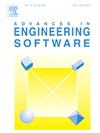石墨烯配筋轻量化板的超音速颤振分析等几何方法
IF 5.7
2区 工程技术
Q2 COMPUTER SCIENCE, INTERDISCIPLINARY APPLICATIONS
引用次数: 0
摘要
近年来,人们越来越重视在广泛的当代跨学科应用中实现高性能、轻量化设计。因此,本文的主要目标是提出一种基于nurbs的等几何方法来全面研究石墨烯增强功能梯度(FG)金属泡沫板的超音速颤振特性。轻质结构的设计结合了两种孔隙率分布和两种石墨烯分散模式,具有均匀和非均匀的配置。在基于nurbs的等高几何分析(IGA)中,使用基于广义高阶剪切变形理论(HSDT)的计算方法推导了控制多孔板动态行为的数学方程。采用一阶近似活塞理论,通过估计高速气流引起的气动力来模拟流固耦合。根据分析方法和其他现有基准结果评估和验证当前方法的准确性。随后进行了几项广泛的参数研究,以实现本研究的主要目标:阐明内部孔隙率和石墨烯纳米填料对轻量化板结构颤振边界和相关振动模式的影响。结果表明,石墨烯增强FG细胞板具有优异的性能,如高刚度和减轻重量,使其非常适合于先进的技术应用。此外,目前的研究结果提供了有价值的见解,可以帮助设计和制造,以提高未来实际工程结构的稳健性和有效性。本文章由计算机程序翻译,如有差异,请以英文原文为准。
An isogeometric approach to supersonic flutter analysis of lightweight-designed plates with graphene reinforcement
In recent years, there has been an increasing emphasis on implementing high-performance, lightweight designs in a wide range of contemporary interdisciplinary applications. The primary objective of this paper, therefore, is to present a NURBS-based isogeometric approach for a comprehensive investigation into the supersonic flutter characteristics of graphene-reinforced functionally graded (FG) metal foam plates. The lightweight structures are designed using a combination of two porosity distributions and two graphene dispersion patterns, featuring both uniform and non-uniform configurations. The mathematical equations governing the dynamic behavior of the porous plates are derived using a computational approach based on generalized higher-order shear deformation theory (HSDT) within a NURBS-based isogeometric analysis (IGA). A first-order approximation of piston theory is employed to model the fluid–structure interaction by estimating the aerodynamic forces induced by high-speed airflow. The accuracy of the current approach is assessed and validated against the analytical approach and other existing benchmark results. Several extensive parametric investigations are subsequently conducted to fulfill the primary goal of this research: to clarify the influence of internal porosity and graphene nanofiller on the flutter boundaries and associated vibrational modes of lightweight-designed plate structures. The obtained results demonstrate that graphene-reinforced FG cellular plates possess exceptional properties, such as high stiffness and reduced weight, making them well-suited for advanced technological applications. Furthermore, the present findings offer valuable insights that can assist in the design and fabrication, with the goal of improving the robustness and efficacy of future practical engineering structures.
求助全文
通过发布文献求助,成功后即可免费获取论文全文。
去求助
来源期刊

Advances in Engineering Software
工程技术-计算机:跨学科应用
CiteScore
7.70
自引率
4.20%
发文量
169
审稿时长
37 days
期刊介绍:
The objective of this journal is to communicate recent and projected advances in computer-based engineering techniques. The fields covered include mechanical, aerospace, civil and environmental engineering, with an emphasis on research and development leading to practical problem-solving.
The scope of the journal includes:
• Innovative computational strategies and numerical algorithms for large-scale engineering problems
• Analysis and simulation techniques and systems
• Model and mesh generation
• Control of the accuracy, stability and efficiency of computational process
• Exploitation of new computing environments (eg distributed hetergeneous and collaborative computing)
• Advanced visualization techniques, virtual environments and prototyping
• Applications of AI, knowledge-based systems, computational intelligence, including fuzzy logic, neural networks and evolutionary computations
• Application of object-oriented technology to engineering problems
• Intelligent human computer interfaces
• Design automation, multidisciplinary design and optimization
• CAD, CAE and integrated process and product development systems
• Quality and reliability.
 求助内容:
求助内容: 应助结果提醒方式:
应助结果提醒方式:


